Grower Profile: W&D Riccini
5th January 2023
Focus on quality and profitability will follow. The primary focus is on good quality top-fruit farming for Kent-based brothers and apple, pear and cherry growers David and William Riccini, of W&D Riccini.
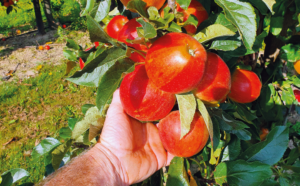
Grower profile:
- Grower: W&D Riccini
- Location: Canterbury, Kent
- Total growing area: 90ha
- Soil type: Brick earth
- Fruit grown: Over 70ha of apples (Gala, Braeburn, Cameo and Magic Star), 9.25ha of pears (Conference), 7.4ha cherries (on dwarfing rootstocks, Gisella 3 & 5, grown in polytunnels)
Founded by their grandfather just after the war in in 1921, who started by growing 16ha (40 acres) of fruit, the family business soon expanded to 101ha (250 acres). The farm was subsequently inherited by David and William’s mother and aunt, who eventually split it and sold most of it off; leaving 16ha, which their mother continued to farm. The brothers, who took over in 1998, have succeeded in rebuilding it back up to 90ha in this time.
Just over 70ha is dedicated to apple trees, and well-known apple varieties Gala and Braeburn are their mainstays. Yields are upwards of 50t/ha for established Gala, and average 70–80t/ha for Braeburn.
They also grow 3.2ha Cameo, and 6.5ha of new trademarked variety Magic Star.
David comments: “This new variety is becoming popular, because not only does it taste good but it also stores very well – it can be stored for more than 12 months, opening the possibility of year-round supply.”
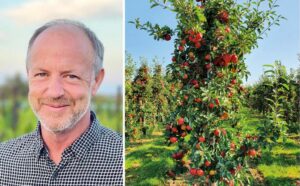
David Riccini pictured above
Grown as clones
The average age of the apple trees is between 9–10 years, with none older than 17 years, and his strategy is to plant an average of 3ha/year with new trees. Most orchards are now on the post and wire system – 3.5m alleyways, 1m apart
within the rows, and 3m high.
“Between 60–70% of the apples we grow are Gala, which are grown as clones. The newer clones with desirable traits such as better skin colour, early ripening or apples which are simply easier have become available,” he explains, noting that older clones can have stripy green variations in colour. “Once we find a particular clone has been outclassed, we change it.”
Some of the Gala clones are Gala One, Royal Beaut, Schniga and the oldest are Mitchgla.
“Gala is a good option for us because it is the most popular UK apple; plus, because it is frost-tolerant, it all but guarantees you a crop.”
However, it has a tendency to overset, so needs thinning by hand to achieve the right size profile for the market – which is 55–80mm. “The most useful size is 62–68mm, so we aim to get as many as possible to that size range,” David shares.
This is because apples are paid for by the kilo with a linked expectation of count, but there is a minimum number of apples per pack, he explains. “If you put eight larger apples in a pack, you are giving away kilos.”
Braeburn are more sensitive to frost, more variable in yield, and hence may become more overset every other year. “Anything that grows over 80mm is left in the field, as it is has no economic market,” he notes.
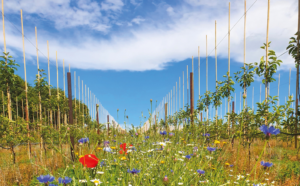
David Riccini has recently begun experimenting with planting wild meadow mix as a cover crop in every fourth alleyway in newly planted orchards instead of plain grass. The aim is to encourage pollinators, improve soil health and suppress problem weeds.
Hitting profitability
In total, between 10% and 15% of the crop can be left in the field, which hits profitability.
On the topic of weed control, David comments: “There are ongoing discussions about best practice, but we recently made the decision to continue to apply a herbicide in a strip under the trees because the soil is not cultivated there, and cultivation is known to release carbon dioxide.
“Firstly, we don’t want trees competing for water and nutrients, but also if you leave weeds such as cleavers and thistles, they can grow quite tall, and go through the branches. Then there is a risk that they may scratch and disfigure the fruit.”
Asparagus, as a weed, is common in the area and David has found it to be insensitive to the normal range of herbicides, so he has to resort to having it dug out.
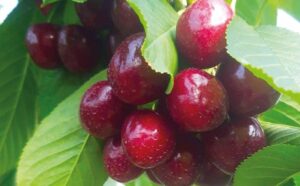
Wet springs play havoc
Being based in a drier corner of the country means that scab (Venturia inaequalis) incidence is slightly less prevalent as in other areas of the country. The fungus survives the winter on fallen leaves and unripe fruits, forming ascospores. When the temperature warms up, these ascospores mature and are subsequently released when they become wet. The pathogen then spreads by airborne spores.
Once infected, plants produce cork as a defence against further growth of the fungus.
“Some of the new varieties are more scab resistant, but wet springs can still play havoc with the blossom, leaves, petioles and the developing fruit,” he says.
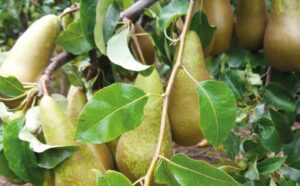
No on-site storage
Discussing post-harvesting, David reveals that they do not have any grading or storage facilities on the farm.
“This would need a great deal of capital to set up efficiently, so we prefer to use professionals who are specialist in this area and possess the sophisticated equipment to realise the necessary economies of scale.
“We aim to concentrate on growing the best crop possible, to invest in orchards and the associated equipment, and not being distracted by extra administration tasks and onerous volumes of paperwork that the running of a pack house involves,” he emphasises.
Once harvested, the apples and pears are sent to AC Goatham & Son, where they are stored, graded and packed before being supplied to Sainsbury’s. The cherries go to AR Neaves for packing, marketing through Berry Gardens, and then are subsequently sold in Marks & Spencer, Aldi, and Sainsbury’s.
“One of the problems with cherries is the poor net return farmers receive when they are sold in packs of 200g,” laments David.
The packaging process costs the farmer around £2.25/kg, he says, adding that there is also an environmental footprint of putting them in a plastic punnet which is heat sealed in with polythene.
“While we understand the supermarket is probably trying to keep the pack below a certain price to achieve a price point of acceptability, it really does not work for the growers.”
The minimum size in the US is equivalent to 454g, and this, he points out, is a much more efficient and sustainable size.
“If the supermarkets would put the minimum size at 400g, we could halve the cost, the waste, and benefit the environment,” he concludes.
